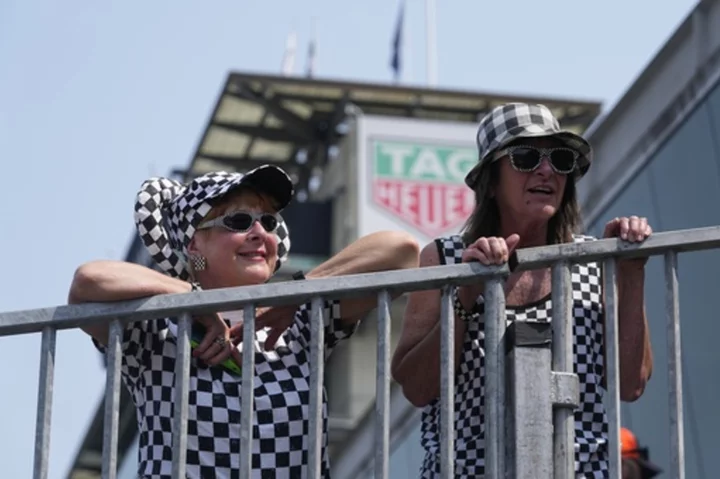INDIANAPOLIS (AP) — When Doug Boles took his dream job as Indianapolis Motor Speedway president, he devoted himself to cleaning up the track's increasingly common race-day blight of empty seats and empty sections.
Sure, that meant selling tickets. But to the lifelong Indianapolis 500 fan, it also meant selling newcomers on the pageantry, pizzazz and purpose of the “Greatest Spectacle in Racing.”
A decade later, Boles has presided over an IndyCar renaissance few saw coming, one that has included the first two announced sellouts since the resumption of the 500 after World War II, what appears to be another near sellout for the 107th running of the race Sunday and potentially even bigger crowds in the future.
“It was painful because my memories and what made me love this place was coming here in 1977 when the seats were full," he said, reflecting on the decline that began in the mid-1990s. “I get the question all the time, what's the Indianapolis 500 like? I don't even know where to begin. You truly, truly have to experience it to describe it."
Boles rebranded the event with a years-long campaign to celebrate the 100th anniversaries of the Brickyard's biggest moments, culminating in 2016 when ticket sales were cut off for what was believed to be the first time in a century of racing.
Race organizers also sold all 135,000 tickets in 2021 when public health officials limited capacity because of the pandemic. Last year's crowd was the largest since 2000, with the exception of 2016, and this weekend will be even larger. Boles said Thursday fewer than 5,000 tickets are available.
It doesn't get much better for a race carrying the mantle of world's largest single-day spectator sporting event. Crowd estimates often exceed 275,000 and potentially climb past 300,000 in the vast infield and stands overseeing the 2.5-mile oval.
Actual ticket sales — and the number of existing permanent seats — remain one of the sports world's greatest mysteries because those numbers are not publicly released. But IndyCar teams and drivers don't need attendance figures to know how much has changed.
“Look at last year when we had the big crowd," said Tony Kanaan, the popular 2013 Indy 500 winner. “I think we had a lot of old hands here, but now we're getting the millenials and I think it's great.”
Last week's practices also drew some of the largest crowds since the speedway started scanning tickets in 2016. Those attending last weekend's qualifying made it feel more like the large, festive Carb Day crowds and there were even long traffic lines for Monday's two-hour practice.
“Qualifying weekend, I thought it was like the best in the last 10 years,” driver Connor Daly said.
After the retirements, the loss of stars like Jeff Gordon and Tony Stewart to NASCAR and the damaging split of American open-wheel racing during the 1990s, the IndyCar Series finally has rebounded with big names and compelling storylines.
Young international stars like Pato O'Ward and Alex Palou and the return of more Formula One drivers have rekindled the enthusiasm Kanaan, four-time 500 winner Helio Castroneves and six-time series champ Scott Dixon injected into the series two decades ago.
American drivers such as Josef Newgarden and Colton Herta have strong, visible fan bases parading around the speedway. The pole-day shootout, the return of bumping and the anticipation of rerecord-breaking qualifying runs have become must-see attractions.
But it was the 2016 race that gave many their first glimpse into the colorful, race-day flavor family members and people like Boles and Chip Ganassi Racing managing director Mike Hull grew up with.
“On race day, the electricity in this place is like putting your finger in a 110 socket and it's because the grandfathers and the great grandfathers brought their sons here and then those dads and moms brought their kids,” Hull said. "It's so cool."
Still, there were complications — none greater than 2020 when pandemic restrictions left the seats completely empty for the first race run under new owner Roger Penske. Boles spent part of that day with fans camped out in a parking lot across the street. He event took the unusual step of announcing fans could keep their beloved streaks of consecutive races attended intact by watching or listening.
"It was really depressing being here,” 2014 race winner Ryan Hunter-Reay recalled. “It just wasn’t the Indy 500. Fans make it go."
Boles learned that lesson first as a fan, then as part-owner of the now defunct Panther Racing team and eventually in the speedway’s front office before he replaced Jeff Belskus in 2013 and embarked on his new mission — bringing fans back home again to his most revered track.
“We just had a lot of people who said, ‘We're in, this is great and we had so much fun,'” Boles said, referring to those lucky enough to attend the 2016 race. “When you get that number of eyeballs out there and they actually see it and experience the race-day sparkle first-hand, that atmosphere I think is a lot of it, especially for somebody who has never experienced it before.”
___
AP auto racing: https://apnews.com/hub/auto-racing and https://twitter.com/AP_Sports

